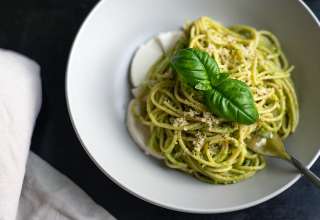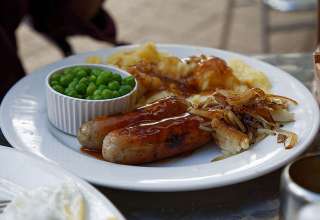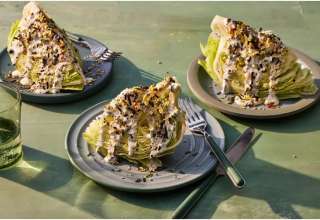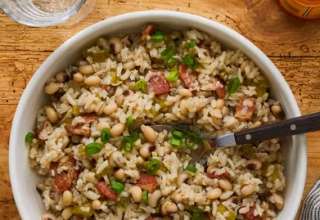
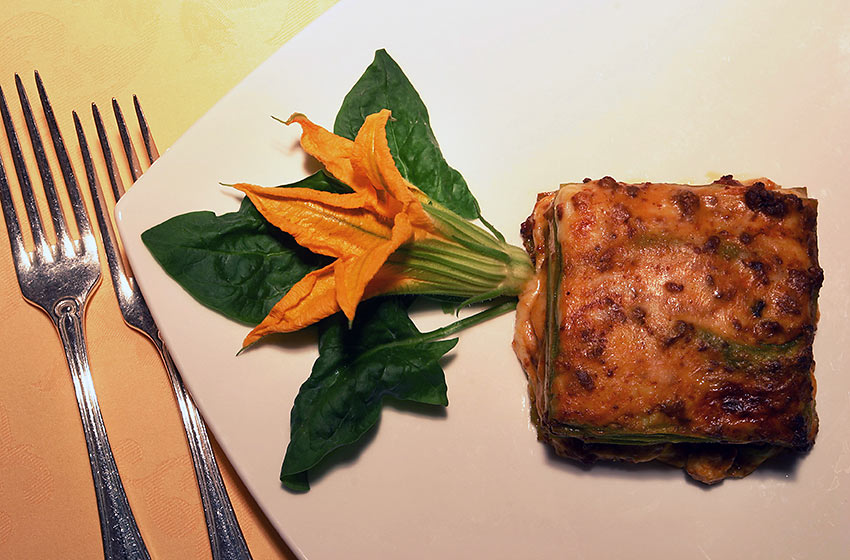
Like many North Americans I grew-up eating lasagna. I recall how my grandmother, who hailed from Genoa, would explain that lasagna was the name of a pasta, not a dish. Her style of preparing lasagna was to boil the pasta, then layer it with a Tucco sauce (Genoese dialect) and Parmigiano–Reggiano cheese, with no baking in the oven.
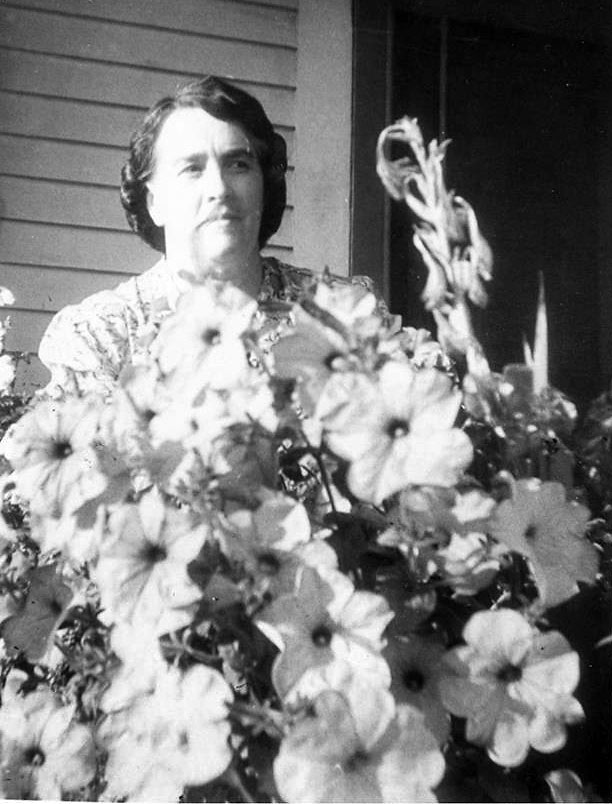 Adelina, my nonna. Photo taken in Seattle, Washington. My love of cooking stems from her.
Adelina, my nonna. Photo taken in Seattle, Washington. My love of cooking stems from her.
Nonna’s legacy is kept alive as we recreate the many dishes in which she taught us.
A classic Lasagne alla Bolognese is different from the version most commonly prepared in the United States. Instead of thick layers of ricotta and mozzarella cheese, Lasagne alla Bolognese features delicate layers of fresh pasta (spinach is traditional, but plain fresh egg pasta works fine), coated in a luxurious mix of hearty Ragù alla Bolognese and a creamy besciamella (béchamel). It’s one of the world’s great baked pasta dishes.
Last year I finally made it to Bologna, long considered the gastronomic capital of Italy. For my last meal, it had to be the quintessential Lasagne alla Bolognese. With the rich Ragù alla Bolognese, it was more rustic than I had imagined, but every bite was still a gift from heaven.
Traditional Lasagne alla Bolognese
Yield: 6 servings
For the Lasagne:
- 4 cups unbleached all-purpose flour
- 6 large eggs
- ½ teaspoon salt
- ½ teaspoon extra virgin olive oil
For spinach pasta, use about ¼ pound of fresh spinach per egg/portion. Cook the spinach in boiling water until it is wilted (only a minute or two). Squeeze the spinach dry, then chop as finely as possible. Add it to the flour well with the eggs.
For the Salsa alla Bolognese:
- ½ cup extra virgin olive oil
- ½ cup butter, cubed
- 1 cup onions, chopped small
- ½ cup celery, chopped small
- ¼ cup carrots, chopped small
- ¼ pound pancetta, ground (you can ask your butcher to do this)
- 1 pound veal
- ½ pound ground beef
- 1 pound ground pork
- 1 cup white wine
- ½ cup tomato paste
For the Besciamella:
- 4 tablespoons butter
- 4 tablespoons flour
- 2 cups milk
- 1/4 teaspoon ground nutmeg
- 3 tablespoons grated Parmigiano Reggiano cheese
- Salt
To prepare the Salsa alla Bolognese:
In a large Dutch oven or saucepan, heat the olive oil and butter. Add the onions, celery and carrots and cook until they become very soft and begin to caramelize. In a large bowl, mix together the pancetta, veal, beef and pork. Add the meats to the pan and cook until they begin to brown. Add the wine and continue to cook until most of the liquid is evaporated—it should just be moist around the edges of the meat. Add the tomato paste and stir well. Bring to a simmer. Reduce the heat to low and cook for 2 hours.
To prepare the Besciamella:
In a medium saucepan, heat the butter until it has melted. Add the flour and stir until the consistency is smooth. Over medium heat, continue to cook until the mixture turns a light golden brown, about 6-7 minutes.
Meanwhile, heat the milk in a separate pan until it is just about to boil. Add the milk to the butter mixture 1 cup at a time, whisking continuously, until it is very smooth and is brought to a boil. Cook the sauce for 30 seconds and then remove it from the heat. Season the besciamella with salt and nutmeg, to taste and set aside until ready to use.
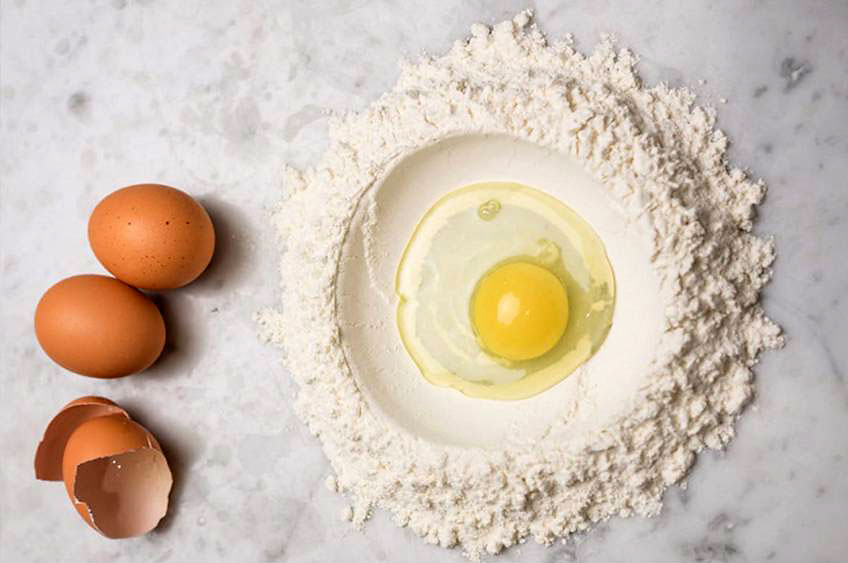
To create the Lasagne:
On a marble or wooden work surface, pile the flour into a mound. Make a well in the center of the mound. In a small bowl, beat the eggs, salt, and olive oil together with a fork until blended, and then pour them in the well. Continue beating the egg mixture with the fork, gradually drawing in flour from the sides of the well until the egg has been absorbed by the flour. If needed, drizzle a small amount of warm water, and continue mixing. Once the dough has formed, clean your hands and the work surface.
Flour the work surface again. Knead the dough: press the heel of one hand deep into the ball, keeping your fingers high, then press down on the dough while pushing it firmly away from you. The dough will stretch and roll under your hand like a large shell. Turn the dough over, then press into the dough, first the knuckles of one hand, than with the other; do this about ten times with the knuckles of each hand. Then repeat the stretching and knuckling process, using more flour if needed to prevent sticking, until the dough is smooth and silky, for about 10 to 20 minutes. Roll the dough into a smooth ball.
Place the dough in a small bowl and cover with plastic wrap. Let the dough rest for at least 1 hour at room temperature or up to 1 day in the refrigerator, before rolling and shaping the pasta. If the dough has been refrigerated, let it stand at room temperature for at least 1 hour before rolling and shaping.
Shape the dough into a rough circle. Lightly flour the clean work surface. With a rolling pin, begin rolling the dough as you would a pastry crust, starting in the center and rolling away from you to the outer edge. Turn the dough a quarter-turn, and repeat, working your way around, until the sheet of dough is 1/8 inch thin or less. Scatter a small amount of flour on the dough whenever it starts to stick to the surface or the rolling pin. Italian tradition dictates that the sheet of dough be transparent enough to read text beneath.
Fresh egg pasta cooks in a flash (think: 10 to 15 seconds). As soon as it rises to the surface of the heavily-salted cooking water, it is likely ready. A taste test will show if it is al dente enough.
To assemble the dish:
Preheat the oven to 375°F.
Assemble the Lasagne in a 10-by-20-inch lasagna pan: spread a layer of Bolognese over the bottom and top with a sprinkling of Parmigiano, a layer of pasta, a layer of besciamella, another layer of Bolognese, a sprinkling of Parmigiano and pasta. Repeat until all the ingredients are used up, finishing with a layer of pasta topped with besciamella, Bolognese and Parmigiano.
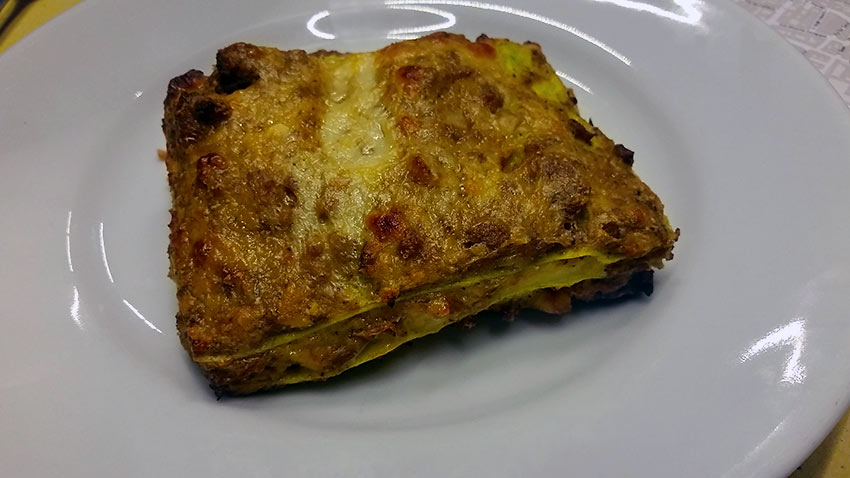
Bake for 45 minutes, or until the edges are browned and the sauces are bubbling. Allow the Lasagna to stand for 10 minutes before serving. Have leftovers? No problem: the flavors will “get better acquainted.”
